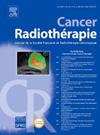成功识别和处理脑辐照后36年发生的卒中样偏头痛发作
IF 1.4
4区 医学
Q4 ONCOLOGY
引用次数: 0
摘要
放射治疗后中风样偏头痛发作综合征是一种罕见的晚发性神经系统疾病,多见于有头颅放射治疗史的患者。它表现为中风样症状,包括偏瘫、偏盲、癫痫发作和偏头痛,通常发生在治疗后数年或数十年。我们报告了一例放疗后中风样偏头痛发作综合征病例,患者男性,51 岁,在接受少突胶质细胞瘤全脑照射治疗 36 年后发病。患者突然出现左侧偏瘫、局灶性癫痫发作和双侧额颞部头痛。脑部核磁共振成像显示,T2流体增强反转恢复序列显示高密度,右顶叶-枕叶皮层回旋增强。患者对为期 5 天的类固醇脉冲疗法(1000 毫克/天)反应良好,临床症状明显改善,核磁共振成像异常也得到缓解。本病例是有文献记载的放疗后中风样偏头痛发作综合征中潜伏期最长的病例之一,它强调了在放射治疗后的患者中考虑这一诊断的重要性,即使是在较长的潜伏期后,以防止误诊和不恰当的治疗。它包括假性中风的症状,包括偏瘫和偏盲,也包括癫痫发作和偏头痛发作,发生在治疗后数年甚至数十年。我们介绍了一例放射治疗后中风样偏头痛发作的病例,患者 51 岁,因少突胶质细胞瘤接受脑部放射治疗 36 年后出现中风样偏头痛发作。患者突然出现偏瘫、局灶性癫痫发作和双侧额颞部头痛。脑部核磁共振成像显示,右侧顶枕皮层的T2流体减弱反转恢复和回旋增强呈高密度。该综合征对皮质类固醇(每天 1000 毫克)的 5 天疗程反应良好,临床症状明显改善,核磁共振成像异常也得到缓解。这是最新记录的一例放疗后中风样偏头痛发作病例,强调了放疗后患者即使潜伏期较长,也应考虑这一诊断的重要性,以避免误诊和治疗不当。本文章由计算机程序翻译,如有差异,请以英文原文为准。
Successful identification and management of a stroke-like migraine attacks after radiation therapy syndrome occurring 36 years after cranial irradiation
Stroke-like migraine attacks after radiation therapy syndrome is a rare, late-onset neurological disorder observed in patients with a history of cranial radiation therapy. It presents with stroke-like symptoms, including hemiparesis, hemianopsia, seizures, and migraines, often occurring years or decades post-therapy. We report a case of stroke-like migraine attacks after radiation therapy syndrome in a 51-year-old male, manifesting 36 years after treatment for oligodendroglioma with whole-brain irradiation. The patient developed sudden worsening of left hemiparesis, focal seizures, and bilateral frontotemporal headaches. Brain MRI revealed hyperintensity on T2 fluid-attenuated inversion recovery sequence and gyral enhancement in the right parieto-occipital cortex. The patient responded favourably to a 5-day course of steroid pulse therapy (1000 mg/day), with significant clinical improvement and resolution of MRI abnormalities. This case highlights one of the longest documented latencies for stroke-like migraine attacks after radiation therapy syndrome and emphasizes the importance of considering this diagnosis in patients after irradiation, even after extended latency periods, to prevent misdiagnosis and inappropriate treatment.
Le syndrome « stroke-like migraine attacks after radiation therapy » est un trouble neurologique rare, d’apparition tardive chez les patients ayant un antécédent d’irradiation cérébrale. Il comprend des symptômes de pseudo accident vasculaire cérébral, incluant l’hémiparésie, l’hémianopsie mais aussi des crises d’épilepsie et de migraines, se déclenchant des années voire des décennies après le traitement. Nous présentons un cas de syndrome stroke-like migraine attacks after radiation therapy chez un homme de 51 ans, apparu 36 ans après une irradiation cérébrale pour un oligodendrogliome. Le patient a vu se développer une aggravation subite d’une hémiparésie, des crises focales et des céphalées bilatérales frontotemporales. L’IRM cérébrale a montré une hyperintensité en séquence T2 fluid-attenuated inversion recovery et un rehaussement gyral dans le cortex pariéto-occipital droit. Le syndrome a favorablement répondu à un traitement de 5 jours de corticoïdes (1000 mg par jour), avec une amélioration clinique substantielle et la résolution des anomalies de l’IRM. Cela met en avant l’un des cas documentés les plus tardifs de syndrome stroke-like migraine attacks after radiation therapy et insiste sur l’importance de penser à ce diagnostic chez les patients ayant bénéficié d’une radiothérapie, et ce, même après de longues périodes de latence, pour éviter un mauvais diagnostic et un traitement inapproprié.
求助全文
通过发布文献求助,成功后即可免费获取论文全文。
去求助
来源期刊

Cancer Radiotherapie
医学-核医学
CiteScore
2.20
自引率
23.10%
发文量
129
审稿时长
63 days
期刊介绍:
Cancer/radiothérapie se veut d''abord et avant tout un organe francophone de publication des travaux de recherche en radiothérapie. La revue a pour objectif de diffuser les informations majeures sur les travaux de recherche en cancérologie et tout ce qui touche de près ou de loin au traitement du cancer par les radiations : technologie, radiophysique, radiobiologie et radiothérapie clinique.
 求助内容:
求助内容: 应助结果提醒方式:
应助结果提醒方式:


